Mushrooms can be an annoying problem in the vegetable garden. They seem to pop up overnight, and before you know it; your plants are covered in them!
Mushrooms will develop in potted plants and vegetable gardens if spores from the potting soil or mulch medium are transferred to the plant.
They’re one of our planet’s most useful organisms, as they help plants to flourish by providing them with nutrients.
A small, flourishing ecosystem is indicated by mushrooms in the soil [1].
Fortunately, several things you can do to get rid of mushrooms from taking over your garden. In this blog post, we will discuss three methods for getting rid of mushrooms in the vegetable garden: chemical control, cultural control, and biological control.
Garden experts will also provide tips on how to prevent mushrooms from growing in the first place!
The Types Of Mushrooms In Potted Plants And The Garden
There are many types of mushrooms, and not all of them are harmful to your plants. In fact, some mushrooms can actually be beneficial to your garden! However, there are a few specific types of mushrooms that you’ll want to watch out for, as they can cause serious damage to your plants.
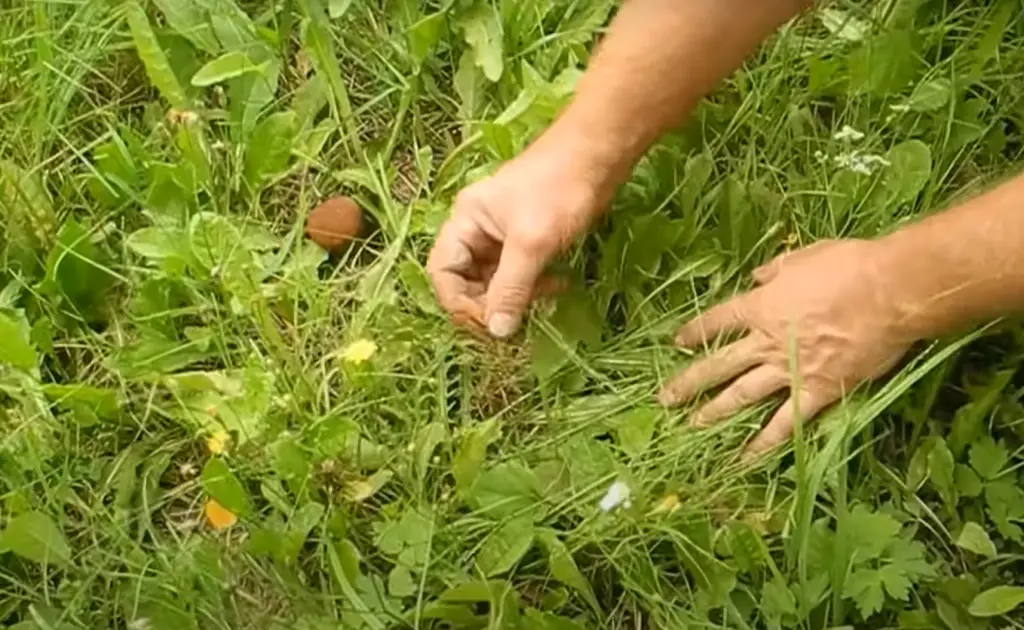
Here are a few of the most common types of mushrooms that can affect your garden [2]:
- Agaricus bisporus. This type of mushroom is also known as the “white button mushroom”. It’s one of the most commonly cultivated mushrooms in the world and is often found in grocery stores. However, this mushroom can also be found growing wild in gardens;
- Pleurotus ostreatus. This type of mushroom is also known as the “oyster mushroom”. It’s a popular edible mushroom that is often cultivated commercially. This mushroom is not particularly harmful to plants but can compete with them for nutrients;
- Flammulina velutipes. This type of mushroom is also known as the “velvet foot”. It’s a popular edible mushroom that is often cultivated commercially. However, it can also be found growing wild in gardens;
Are There Any Benefits Of Having Mushrooms In The Garden?
Mushrooms can aid your garden in a variety of ways. They assist decompose complex organic matter, such as wood chips, rotting leaves, and mulch, into nutrients that your plants may utilize.
Mushrooms in your yard are an indication that the soil is healthy. Mushrooms will not harm your plants, instead, they enter a mutually beneficial relationship with them.
During the decomposition process, they replenish the soil with minerals.
Mushrooms also assist plants in communicating with one another, according to scientific studies. In the event of insect damage, they help create a communication system for plants to send distress signals to each other.
Consider planting some nearby plants in a row, like asparagus or garlic, to help them prepare for an attack [3].
Are Mushrooms A Sign Of Damp Or Wet Soil?
Mushrooms are often thought of as a sign of damp or wet soil. However, this is not always the case. Mushrooms can also grow in dry conditions.
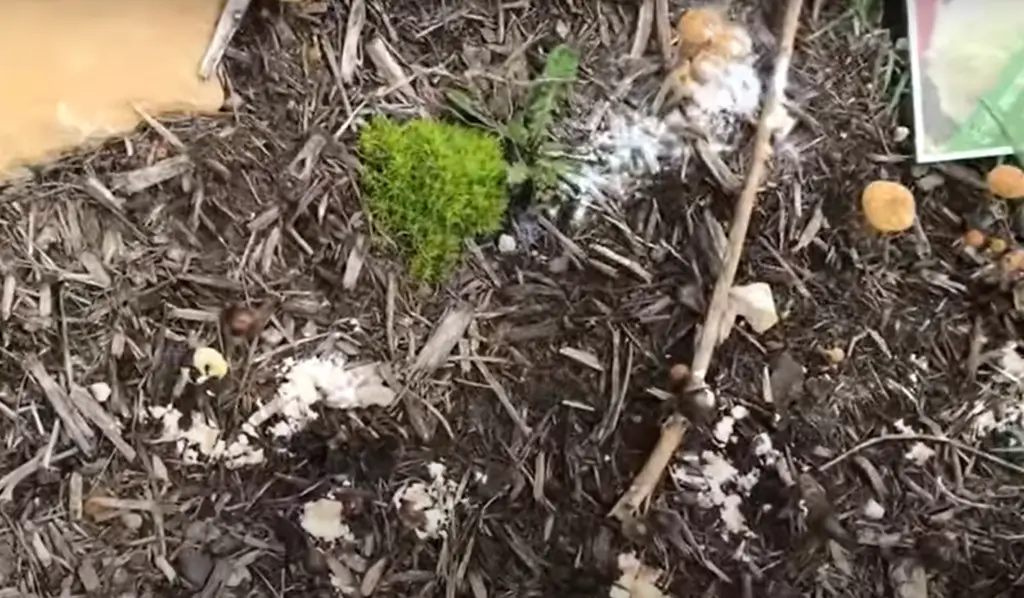
The best way to determine if mushrooms are growing in your garden because of damp or wet soil is to look for other signs of moisture, such as [4]:
- pooling water;
- soggy ground;
- moist air;
If you see any of these signs, it’s likely that the mushrooms are growing because of too much moisture in the soil. To get rid of them, you’ll need to address the underlying issue and make sure your garden is well-drained.
Should You Remove Mushrooms From The Garden?
Remove the mushrooms only if necessary. They have several advantages, and they provide a lovely touch to the soil as they develop quietly beneath the plant leaves.
Mushrooms in the soil are a good indication that the dirt is healthy and does not endanger plant or potted succulents. Mushrooms may be picked by hand. They will complete their lifecycle, decay, and recycle nutrients in the soil if left alone.
Mushrooms, according to several studies, absorb elements from the earth [5]. The minerals are both beneficial and poisonous in different circumstances. However, this is determined by the soil quality in which they grow.
In one research, it was discovered that using Spent Mushroom Compost (SMC) improved plant growth and fruit production [6]. The findings of these studies were reviewed in light of the application of SMC as an organic fertilizer for vegetable development.
Nevertheless, the soil in your garden is nutrient-dense and contains amendments and organic material that will feed the plants as they decay.
What Causes Mushrooms To Grow In Your Garden:
Mushrooms Love Moist And Humid Areas
Mushrooms appearing in your raised garden bed is an annoyance, and they may appear after a wet season.

Excess water in the soil can also encourage mushrooms to grow. Excess water in your garden will result in greater variety and a higher count of mushrooms [7].
Mushrooms are best cultivated in a warm, well-ventilated location with excellent drainage. They also require moist growing media such as cow dung or composite.
They Prefer Alkaline Soils
Mushrooms are fungi, and they have a mycelium network that helps them to spread out and invade an area. This mycelium will produce fruiting bodies that we commonly know as mushrooms.
Mushrooms prefer alkaline soils with a pH of above seven. If your garden soil is too acidic, it can encourage the growth of mushrooms.
You can test your garden soil’s pH level with a simple testing kit from your local nursery or hardware store.
If you find that your garden soil is too acidic, you can add lime to raise the pH level.
Growing Medium
Mushrooms can also grow in a variety of different substrates or growing mediums.
Some of the most common substrates for mushrooms include straw, sawdust, and wood chips.
You can also find mushrooms growing on trees, fallen leaves, and even dung.
Mushrooms will often colonize an area and then begin to break down the organic matter that they are growing on.
This is one of the reasons why mushrooms are often found in mulch or other decaying organic matter.
Poor-Drained Soils
Mushrooms can also grow in poorly-drained soils.
This is because the excess water in these soils provides the perfect environment for mushrooms to thrive.
If you have mushrooms growing in your garden, it is likely that you have a drainage problem.
You can improve the drainage of your soil by adding organic matter such as compost or mulch.
You can also add sand or gravel to help improve drainage.
Improving the drainage of your soil will also help to discourage the growth of mushrooms.
Low Light
Mushrooms lack chlorophyll and require no photosynthesis. Mushrooms are fungi that can endure limited light. They may grow in the absence of sunlight.
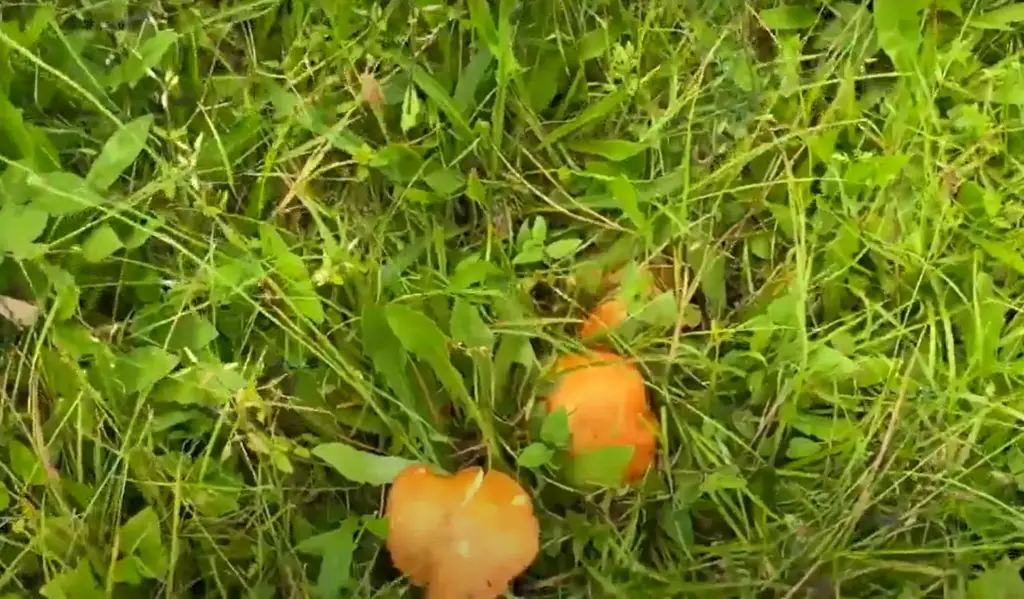
They prefer shady environments. Mushrooms may fruit without the need of sunlight. They will, nevertheless, appear odd. Sunlight has no impact besides determining how the mushrooms grow.
How To Stop Mushrooms Growing In Your Garden (Besides Hand Removal)
Use Copper Sulfate
If you have a problem with mushrooms growing in your garden, you can use copper sulfate to kill them. This chemical is available at most hardware and home improvement stores.
The copper sulfate will kill the mushrooms and their roots, so they won’t be able to grow back.
You can also use copper sulfate as a preventative measure by sprinkling it around the perimeter of your garden bed. This will create a barrier that stops mushrooms from being able to take root in your soil.
Use a Bordeaux Mixture
The first step is to make a Bordeaux mixture. This can be done by mixing together [8]:
- 15 gallons of water;
- 14 cups of limestone;
- 16 cups of hydrated lime;
- 12 tablespoons of copper sulfate pentahydrate;
After the ingredients are mixed together, use a garden hose to apply the mixture over the area where mushrooms are growing. Make sure to drench the area and soak it until runoff occurs.
This should be done every two weeks or after it rains.
Doing this will help to raise the pH level of the soil and make it inhospitable for mushrooms.
Mulching
Mulching is one of the most effective ways to get rid of mushrooms in your vegetable garden. By creating a barrier between the soil and the air, mulch prevents mushrooms from receiving the moisture and nutrients they need to grow.
There are many different types of mulch you can use – including bark chips, straw, and leaves. You can also purchase mushroom-resistant mulches at your local nursery or gardening store.
Add Nitrogen Fertilizer
Mushrooms need nitrogen to grow. By adding nitrogen fertilizer to your garden, you can make it less hospitable for mushrooms. Look for a fertilizer with a high nitrogen content and follow the instructions on the package for application rates.
Spraying With Vinegar Solution
You can make a vinegar solution to spray on the mushrooms.
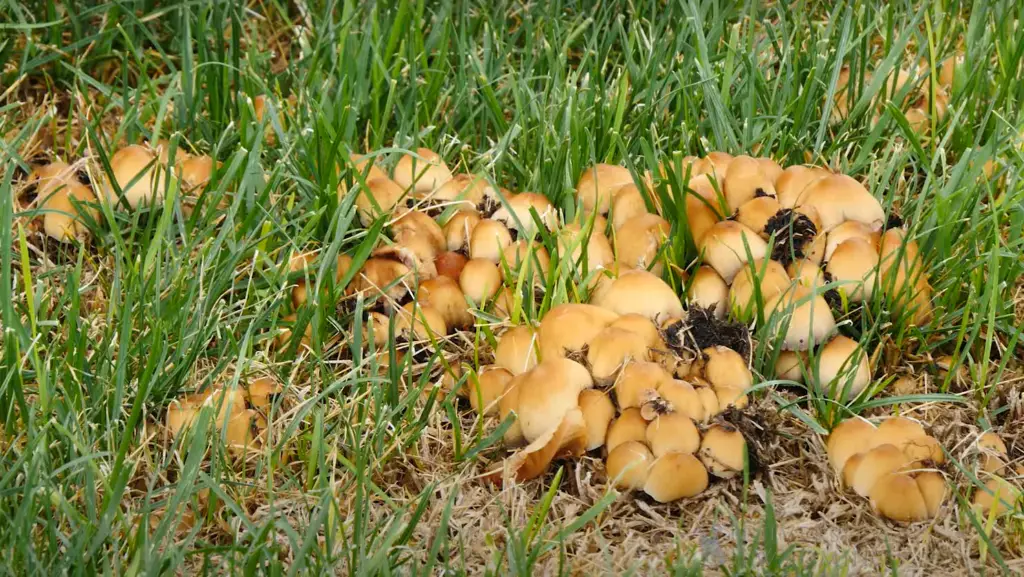
This will kill the mushrooms and stop them from growing. You will need [9]:
- White vinegar;
- Water;
- Spray bottle;
Mix equal parts of white vinegar and water in the spray bottle. Shake it up to mix it well. Spray the solution on the mushrooms. Be sure to get the underside of the mushroom caps too. You may need to reapply after rain or if new mushrooms appear. Vinegar is safe for people, pets, and plants, so you don’t have to worry about harming anything else in your garden.
Change The Growing Environment
The most important thing you can do to control mushrooms is to change the environment in your garden. Mushrooms need four things to grow: food, water, warmth, and darkness. If you can remove one or more of these things from the equation, you’ll be well on your way to getting rid of mushrooms for good.
One way to make your garden less hospitable for mushrooms is to improve drainage. If your soil is too wet, it creates the perfect conditions for fungi to thrive. To improve drainage, add organic matter like compost or peat moss to your soil. This will help absorb excess moisture and keep the roots of your plants dry. You can also raise the level of your garden bed by adding more soil. This will help ensure that water runs off instead of pooling around your plants.
Another way to change the environment in your garden is to increase air circulation. Fungi love humid, still air. By increasing the airflow in your garden, you’ll make it less hospitable for mushrooms. One way to do this is to choose plants that have a high transpiration rate. These plants release water vapor into the air, which helps create a drier microclimate around them.
One more way to increase airflow is to simply rake up any dead leaves or other debris that’s lying on the ground. This will allow more air to circulate and discourage fungi from growing.
Make DIY Soil And Compost Amendments
Mushrooms are the fruit of fungi that live in your soil, so getting rid of them means addressing the conditions they need to thrive. The first step is to improve your drainage and aeration.
If you have sandy soils, you can add compost to help hold water and nutrients. You can also use a tiller to loosen compacted soils [10].Another way to discourage mushrooms is to make sure your garden beds are getting enough sunlight. Mushrooms prefer dark, damp conditions, so increasing air circulation and light will make it harder for them to establish themselves. If you have mulch around your plants, make sure it’s not too thick. A layer of two to three inches is ideal.
You can also try a few natural fungicides, like neem oil or sulfur. These won’t kill the fungi outright, but they will make it harder for them to produce mushrooms. Be sure to follow the instructions on the label, and reapply as needed.
Use Soap And Water
Mushrooms love damp, dark places. Soap and water can help to remove them by making the environment less hospitable.
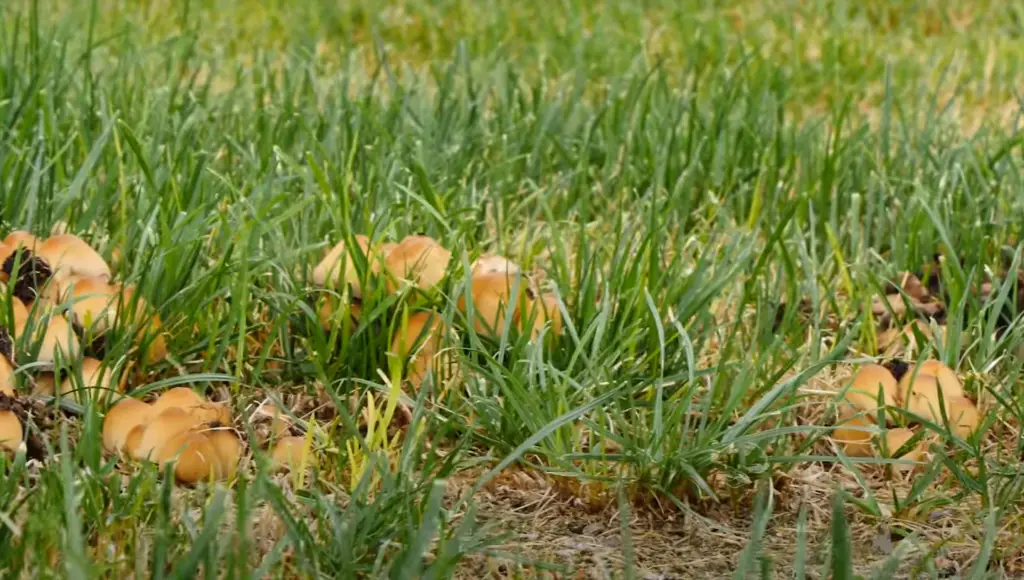
Apply a mixture of dish soap and water directly to the mushrooms using a sponge or cloth. You may need to scrub lightly to get rid of all the dirt and grime that they’ve collected. Rinse the area with clean water afterward.
This method is best used as a preventative measure rather than a cure, as it won’t kill existing mushrooms. But it will make it harder for new ones to take root.
Reduce The Amount Of Water In Your Garden
Mushrooms thrive in damp conditions, so one of the best ways to get rid of them is to reduce the amount of moisture in your garden.
You can also try planting mushrooms in raised beds to improve drainage.Turn The Soil And Aerate It
This will aerate it and allow the water and air to circulate better. It also helps to break up any compacted areas where mushrooms might be growing.
If you have many mushrooms, you may need to do this more than once.
You can also add some organic matter to the soil, such as compost or manure, which will help improve its drainage.
Comparison of Different Methods to Get Rid of Mushrooms in Vegetable Garden
Mushrooms can be a common problem in vegetable gardens, as they can grow rapidly and compete with your plants for nutrients and water. To help you choose the best method to get rid of mushrooms in your garden, we have compared various indicators for different approaches.
| Method | Effectiveness | Cost | Time Required | Safety |
|---|---|---|---|---|
| Removing mushrooms by hand | Low | Free | Long | Safe |
| Using vinegar | Low | Inexpensive | Short | Safe |
| Applying fungicide | High | Expensive | Short | Unsafe if not used properly |
| Improving drainage | Low | Inexpensive | Long | Safe |
We have compared four different methods to get rid of mushrooms in a vegetable garden:
- Removing mushrooms by hand: This method involves physically removing the mushrooms from the garden. It is low in effectiveness as it may not eliminate the root of the problem, and it can be time-consuming. However, it is free and safe to use.
- Using vinegar: This method involves spraying vinegar on the mushrooms to kill them. It is also low in effectiveness, but it is relatively inexpensive and requires less time than removing mushrooms by hand. It is also safe to use.
- Applying fungicide: This method involves using a chemical fungicide to kill the mushrooms. It is the most effective method, but it can be expensive and requires proper handling and application to ensure safety.
- Improving drainage: This method involves improving the drainage in the garden to prevent the growth of mushrooms. It is also low in effectiveness, but it is relatively inexpensive and safe to use.
So, the most effective method to get rid of mushrooms in a vegetable garden is applying fungicide, but it can be expensive and requires proper handling. If you prefer a low-cost and safe method, using vinegar or improving drainage can be good options, although they may not completely eliminate the problem. Removing mushrooms by hand can also be an option, but it can be time-consuming and may not be very effective.
FAQ
Why does my garden keep growing mushrooms?
Mushrooms are a type of fungi that reproduce by releasing spores into the air. These spores can travel long distances and land in your garden, where they will start to grow new mushrooms. While some mushrooms are edible, others can be poisonous, so it’s important to get rid of them as soon as you spot them.
What is the best way to get rid of mushrooms?
The best way to get rid of mushrooms is to remove them by hand, taking care not to spread the spores. You can also try raking the area to disturb the spores and prevent new mushrooms from growing. If you have a serious problem with mushrooms, you may need to use fungicides.
Should I pull mushrooms out of my garden?
If the mushrooms are growing on your lawn, you can mow them down (assuming they’re not poisonous). But if they’re in your garden beds, you’ll need to take a different approach.
Mushrooms are actually the fruit of a fungus that lives in the soil. The part of the fungus that you see above ground is just the tip of the iceberg. Most of it is hidden underground, where it’s busy decomposing organic matter like fallen leaves and dead roots.
This makes mushrooms an important part of the ecosystem – they help recycle nutrients back into the soil.
How does vinegar get rid of mushrooms?
Apple cider vinegar, for example, contains 5% to 7% acetic acid. Acetic acid is present in industrial vinegar at levels of 10% to 70%. Natural horticultural vinegar includes 10 to 30 percent acetic acid.
Vinegar destroys the mushrooms by burning them when sprayed on their surface. The surprising thing is that the visible surface mushrooms are actually fruits from the mushroom [11].
What do toxic mushrooms look like?
Most toxic mushrooms are white, red, or yellow. They often have spots or streaks of these colors on their caps. Some poisonous mushrooms may look similar to edible varieties, so it’s important to know what you’re looking for. If you’re not sure whether a mushroom is safe to eat, don’t take the risk!
Some common poisonous mushrooms include:
- Amanita phalloides (death cap);
- Galerina marginata (deadly galerina);
- Lepiota bruneaformis (brown lepiota);
- Conocybe filaris (filarial conocybe);
- Pluteus atromarginatus (black-spored pluteus);
How can a mushroom appear to grow overnight?
Mushrooms are the fruiting bodies of fungi – they grow by consuming organic matter. Mushrooms can appear to grow overnight because they don’t need sunlight to produce their food. Instead, they rely on decomposing plant material for sustenance. This is why you’ll often find mushrooms growing in mulched areas or near decaying wood.
While most mushrooms are harmless, some varieties can be damaging to your vegetable garden.
For example, the fly agaric mushroom (Amanita muscaria) is a poisonous variety that can kill animals and make humans sick. If you suspect that there are harmful mushrooms growing in your garden, it’s best to remove them as soon as possible.
What kills mushrooms in mulch?
One method is simply to remove the mushroom caps from the mulch. This can be done by hand, but it is often more effective to use a rake or hoe to loosen the soil and then pull the mushrooms out by their stems.
Another way to kill mushrooms in mulch is to treat the area with a fungicide. This will kill not only the mushrooms but also any spores that might be present in the soil. Be sure to follow the directions on the fungicide label carefully, as some products may be harmful to plants.
Finally, you can change the pH of your soil by adding lime. This will make it less hospitable for mushrooms and other fungi.
Do the gardening chemicals work to get rid of the mushrooms?
The chemicals might work, but they can also be harmful to your plants. If you don’t want to use chemicals, you can try solarization. This is a process of using the sun’s heat to kill the fungi. To solarize, you’ll need to water your soil well and then cover it with clear plastic for six to eight weeks during the summer. The heat from the sun will kill the fungi and their spores. You can also try physical removal, like shoveling them up or taking them out of your garden beds. Finally, make sure you’re not overwatering your garden as this can create conditions that are conducive to mushroom growth.
What types of mushrooms grow in vegetable gardens?
There are many types of mushrooms that can grow in vegetable gardens, including the following: white button mushrooms, oyster mushrooms, shiitake mushrooms, and reishi mushrooms.
Mushrooms generally prefer dark and damp conditions to grow properly. This is why they are often found growing in wooded areas or near bodies of water. However, they can also thrive in well-lit areas if there is enough moisture present.
White button mushrooms are the most common type of mushroom found in home gardens. They have a light brown cap with white gills on the underside. The stem is typically short and thick. These mushrooms can be found growing on soil, mulch, or even on dead leaves and twigs.
What are the dangers of having mushrooms in your garden?
Mushrooms can be dangerous to have in your garden for a few reasons. First, they are often a sign of poor drainage and compacted soil, which can lead to other problems like root rot. Additionally, some mushrooms are poisonous, and even those that aren’t can be harmful if ingested in large quantities. Finally, mushrooms can also be hosts for various pests and diseases. If you have mushrooms growing in your garden, it’s best to get rid of them as soon as possible.
There are a few different ways to get rid of mushrooms in your garden. One is to simply pick them up by hand and dispose of them properly (i.e., don’t just leave them lying around). This method is most effective when the mushrooms are young and haven’t had a chance to spread their spores.
Another method is to use a fungicide, although this should be used as a last resort since it can also kill beneficial fungi. There are many different types of fungicides available, so be sure to read the label carefully and choose one that’s specifically designed to kill mushrooms.
Finally, you can also try solarizing the soil. This involves covering the affected area with clear plastic for several weeks in order to heat up the soil and kill the mushrooms (and their spores). This method takes some time and effort, but it’s generally considered to be safe and effective.
Do the mushrooms pose a health risk to you or your plants?
Fungal pathogens pose a great risk to crops and may cause total crop loss. Some varieties can cause stomach upset if ingested. If you have young children or pets who might be tempted to eat the mushrooms, it’s best to remove them.
Mushrooms can also be a sign that your garden is too damp or shady. If you find mushrooms growing in your vegetable garden, consider aerating the soil and adding more light.
What’s the best way to get rid of mushrooms?
The easiest way to get rid of mushrooms is to simply pick them and throw them away. You can also rake them up and compost them. Some people choose to spray their mushroom patches with fungicide, but this is generally unnecessary unless the mushrooms are causing serious harm to your plants.
If you have a persistent problem with mushrooms, you may need to change the conditions in your garden. Be sure to aerate the soil and add more light if needed. You can also try spreading a thin layer of lime over the affected area. This will raise the pH of the soil and make it less hospitable to mushrooms.
Can you safely remove the mushrooms by hand?
If the mushrooms are small and you can reach them, then yes, go ahead and pluck them out. But if they’re too deep down or if they keep coming back no matter how many times you remove them, then there’s probably a bigger issue at hand.
Mushrooms are actually the fruiting bodies of fungi that live in the soil. The main body of the fungus is made up of long, thin strands called hyphae. These hyphae absorb nutrients from decomposing organic matter in the soil and help to break it down further. Some fungi also form symbiotic relationships with plant roots, helping the plant to uptake essential nutrients.
While most fungi are beneficial to gardens and ecosystems, some species can cause problems. The fungi that cause mushrooms to fruit in your garden are probably not doing any harm to your plants, but they can be a sign that there is too much organic matter in the soil.
If you have mushrooms popping up regularly, the best thing to do is to rake them up and remove them from the area. You can also try aerating the soil and adding some sand to improve drainage. If the problem persists, you may need to consult a professional for help identifying and treating the underlying issue.
Will removing the mushrooms kill them or just make them go away?
If you remove the mushrooms, they will eventually die. However, it is important to note that the spores of the mushroom can remain in the soil for years. This means that if conditions are right, the mushrooms can come back. The best way to prevent this from happening is to make sure that you remove as much of the spore-containing material as possible. This can be done by raking up any visible mushrooms and then removing the top layer of soil where the mushrooms were growing. Finally, you should consider adding a new layer of mulch or topsoil to your garden beds to help discourage future growth.
Doing all of this may seem like a lot of work but it is worth it if it means getting rid of those pesky mushrooms for good!
Is there an organic way to get rid of mushrooms in a vegetable garden?
Yes, there are a few organic ways to get rid of mushrooms in a vegetable garden. One way is to remove the mushroom caps and throw them away. Another way is to till the soil in your garden beds to disrupt the fungal growth. You can also add mulch or compost to your garden beds to help improve drainage and discourage mushroom growth.
You can add two tablespoons of baking soda to a gallon of water and stir until well dissolved. Apply the mixture to the mushrooms and the surrounding soil. This will change the pH of the soil and make it uninhabitable for mushrooms.
Can you use bleach to get rid of mushrooms in a vegetable garden?
Most people believe that bleach can help to remove mushrooms from their gardens. However, this is not the best solution as bleach is a harsh chemical and can potentially damage your plants. If you decide to use bleach, make sure to dilute it properly and avoid coming into contact with the mushrooms directly.
Another popular method for getting rid of mushrooms is through the use of vinegar. Vinegar is much safer than bleach and will not harm your plants. Simply mix equal parts vinegar and water in a spray bottle and spritz the mixture onto the mushrooms. The acidity in the vinegar will kill the fungi and prevent them from growing back.
Do mowing mushrooms spread them?
If you mow or rake over mushrooms, it is more likely that their spores will spread across your lawn. This is because the spores are released into the air when the mushroom is disturbed. If you have a problem with mushrooms in your lawn, it is best to leave them alone and let nature take its course. The mushrooms will eventually disappear on their own.
Mushrooms can also spread through your vegetable garden if you are not careful. If you have mushrooms growing in your vegetable garden, make sure to remove them as soon as possible. You don’t want the spores to spread to your other plants and vegetables.
Will lime get rid of mushrooms?
Lime will not get rid of mushrooms, but it can help to prevent them from growing. To use lime, simply sprinkle it around the affected area. You can also add lime to your compost pile to help discourage mushroom growth. Also, make sure that your garden is getting enough sunlight and air circulation, as mushrooms thrive in dark, moist environments.
If you’re still having trouble with mushrooms, you can try using a fungicide. However, be sure to read the label carefully and follow the directions, as some fungicides can harm plants.
Useful Video: How to Kill Mushrooms 🍄
Final Words
Eliminating mushrooms from your vegetable garden can be a difficult task, but it is possible. Start by identifying the type of mushrooms you have in your garden and then determine the best course of action for removal. It may take multiple treatments to completely remove the mushrooms, so make sure to be patient and persistent. Additionally, prevention is key – practice good hygiene, use sterile soil and compost, and plant vegetables in raised beds.
References:
- https://flourishingplants.com/mushrooms-growing-in-vegetable-garden/
- https://flourishingplants.com/mushrooms-growing-in-vegetable-garden/
- https://www.fallsgarden.com/mushrooms-in-vegetable-garden/
- https://gardenersyards.com/mushrooms-in-garden-raised-bed-how-to-get-rid/
- https://link.springer.com/article/10.1007/s00217-017-2881-7
- https://www.researchgate.net/publication/332678280_Spent_mushroom_compost_SMC_-_retrieved_added_value_product_closing_loop_in_agricultural_production
- https://gardenersyards.com/mushrooms-in-garden-raised-bed-how-to-get-rid/
- https://ipm.ucanr.edu/PMG/PESTNOTES/pn7481.html
- https://flourishingplants.com/mushrooms-growing-in-vegetable-garden/
- https://farmfromhome.com/this-is-why-mushrooms-grow-in-your-vegetable-pots/
- https://farmingmethod.com/how-to-get-rid-of-mushrooms-in-lawn-with-vinegar/





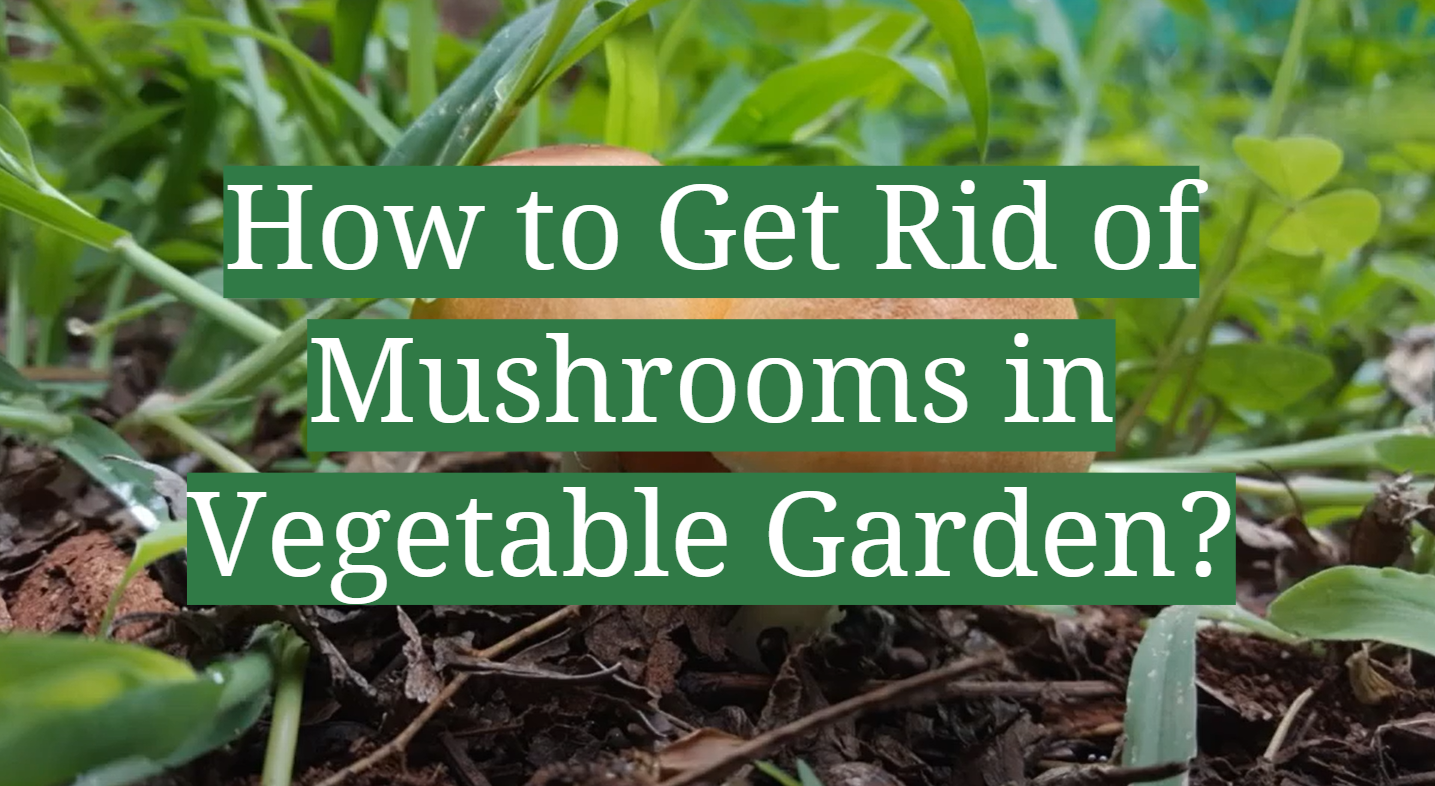



I would recommend using a fungicide to kill mushrooms in your yard. Fungicides are designed to specifically kill fungi, and so they will be effective at getting rid of mushrooms. Be sure to read the label of any fungicide you use, however, to make sure it is safe for use in your garden. Another option is to use a herbicide. A herbicide is a chemical that kills plants. There are several types of herbicides available, and you will need to select one that is specifically labeled for use on mushrooms. Be sure to read the label carefully and follow all instructions. Lastly, you can try using a pesticide. A pesticide is a chemical that kills insects or other pests. There are several types of pesticides available, and you will need to select one that is specifically labeled for use on mushrooms. Be sure to read the label carefully and follow all instructions.